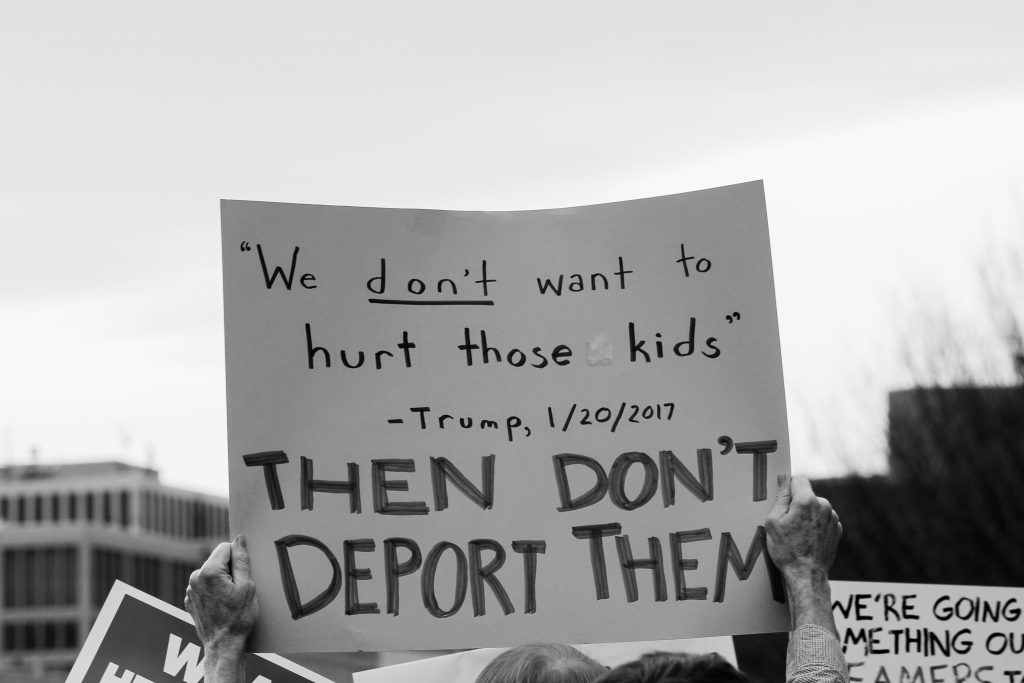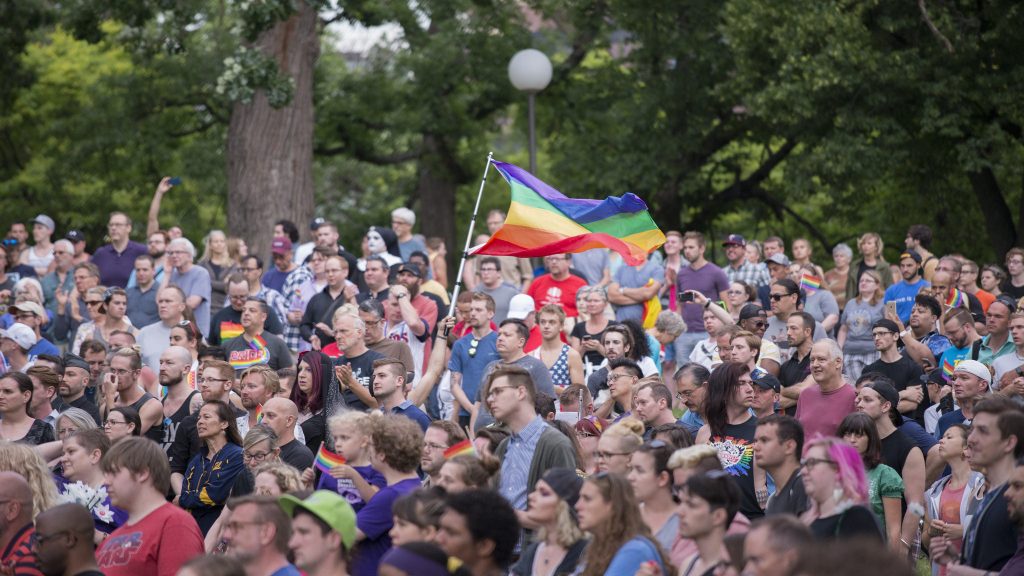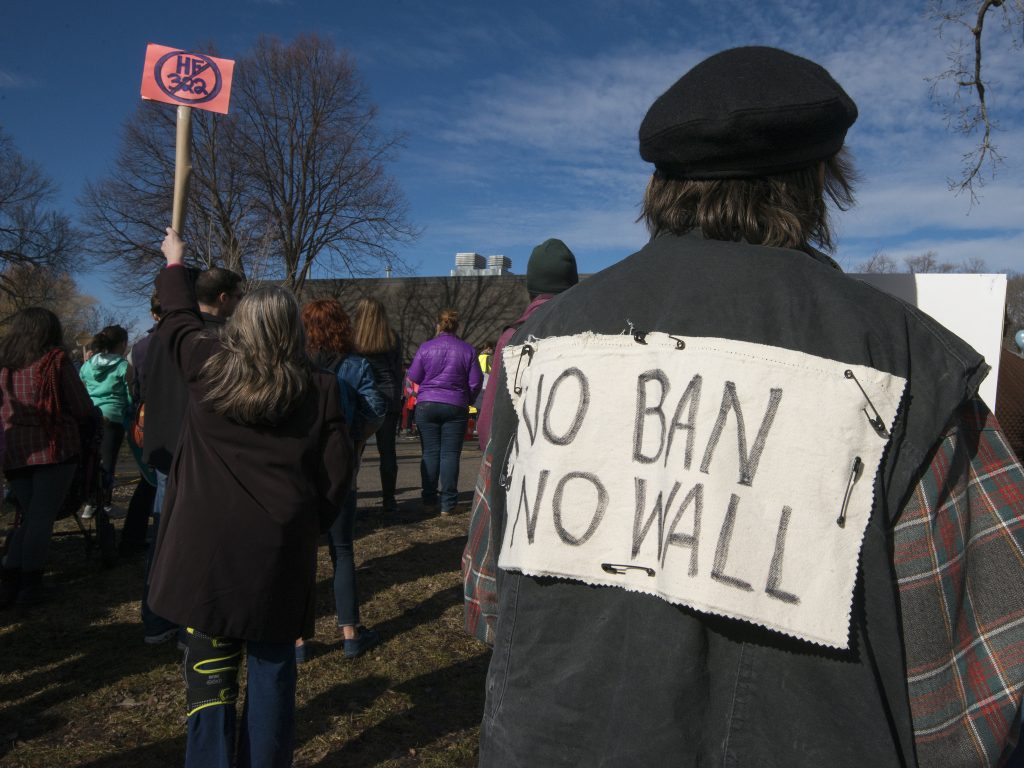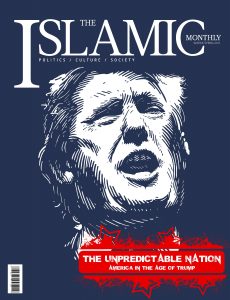Seven days after becoming U.S. president, Donald Trump signed Executive Order 13769, temporarily banning refugees and migrants from seven countries: Syria, Iraq, Iran, Libya, Somalia, Sudan and Yemen. Although the president described the ban as an effort to protect the U.S. from foreign terrorism, the order was largely understood as a “Muslim ban” consistent with his campaign promise to prohibit the arrival of more Muslims in the U.S. Challenged by Washington State Attorney General Bob Ferguson, the ban didn’t last long. Questioning both the motives and effects of the president’s order, Ferguson issued a temporary restraining order effectively blocking the federal government from enforcing the order soon after it was issued. By early February, the Department of Homeland Security suspended all actions related to the ban. But the president didn’t give up. On March 16, Trump issued a second travel ban, this time with a few modifications. Like the first one, Syrian refugees were indefinitely banned from the U.S. along with five of the original countries listed. Unlike the first ban, however, Executive Order 13780 took Iraq off the list. To date, the newer order remains in place and with significant support; a Consult/Political poll in February suggests that 54% of registered voters support the ban.
Although the new ban has not gone unchallenged — a federal court will hear arguments on the new executive order in Seattle on May 15 — it demonstrates a clear effort by President Trump to institutionalize some of the most alarming dimensions of his campaign commitments. Seen in conjunction with the recent strengthening of the Immigration and Customs Enforcement (ICE), and the ongoing push to build a wall between the U.S. and Mexico, the so-called travel ban reveals nothing short of a xenophobic policy of nationalism worth understanding and dismantling.
To understand Trump’s Muslim/refugee ban, it is worth returning to Trump’s campaign. Since the beginning of his effort to win the presidency, immigration and the question of refugees have been at the center of his politics. During his presidential announcement speech in June 2015, for example, Trump listed Mexican immigration as one of the problems with America. The Mexican government, he claimed, was sending criminals, drug dealers and rapists across the border. Although he assumed some Mexican immigrants were good people, he believed Mexico pushed its “worst” people with “lots of problems” across the border, making the U.S. vulnerable to their predatory inclinations. Six months after his announcement speech and the mass shooting in San Bernardino by a Muslim, Trump called for a complete ban on Muslim immigration into the U.S., a position he repeated throughout his campaign. After the Paris attacks at the Bataclan theater, Trump described the admission of Syrian refugees as a potential “Trojan horse” for terrorists, while ignoring the fact that many Syrians are fleeing the very terrorists he’s concerned about. Condemning German Chancellor Angela Merkel for allowing refugees into Germany, he later called for increased surveillance in U.S. mosques “because a lot of talk is going on at the mosques.”

An anti-Trump protest in D.C. > Flickr/Joe Flood
Speaking at a rally in Rhode Island the following year, Trump implored residents to “lock their doors” to keep safe from Syrian refugees. During the speech, he claimed the government had no idea who it was resettling and demanded the end of the Syrian refugee resettlement in the U.S. In August 2016, Trump delivered his immigration speech in Phoenix, Arizona. Having just returned from Mexico, his words offered the clearest articulation of his positions on immigration in a 10-point plan that included building a wall along the southern U.S. border and the abolition of sanctuary cities. Grossly exaggerating the connection between refugees and terrorism, Trump also called for the suspension of visa and resettlement programs for anyone coming from countries where “adequate screening cannot occur,” such as Syria and Libya. He then offered one of the more concerning and racist (if not ironic) positions on immigration reform: an ideological certification program. Designed to ensure that all immigrants share “our values and love our country,” the program would inquire into immigrant attitudes toward issues like “honor killings, about respect for women and gays and minorities, attitudes on Radical Islam, and many other topics.”
Whatever Trump’s true motives for such policies, it’s clear that many of his supporters were attracted to his positions on immigration and refugees. According to a recent Pew Research Study, a majority of Trump supporters saw immigration as a “very big problem” for the country. In addition to Trump’s vision of a southern border wall, at least half of his supporters have also expressed support for a ban on Muslim immigration to the U.S. While data examining opinions about the connection between immigration and terrorism seem hard to come by, the fact that both immigration (66%) and terrorism (65%) are among the top issues for Trump supporters, it is fair to assume that the two are in some ways connected. If terrorism is seen as an external issue of foreign individuals attacking Americans, then limiting further immigration seems like an easy solution to the problem. Block immigration and you block terrorism.
Historical anti-immigration attitudes in the U.S.
While Trump’s campaign is exceptional in many ways, it’s important to recognize that the current trends against immigration are not entirely new. Throughout U.S. history, anti-immigration attitudes have been a fairly consistent phenomenon among the electorate. In 1958, for example, more than half of Americans disapproved of a plan to resettle 65,000 refugees fleeing the communist government in Hungary. About 60% of Americans rejected a 1979 plan to double the number of refugees admitted from Indochina, while about 70% of Americans polled in 1980 rejected Cuban resettlement in the U.S. Although the specifics of each case may suggest different reasons for rejecting the resettlement of these communities, it’s worth noting that American voters have historically opposed large immigration plans. In this sense, support for Trump’s immigration policies is not entirely new. It points to a rejectionist trend among some American voters who, for various reasons, oppose immigration plans despite the conditions of displacement.
Trump’s position on immigration presents an extreme and even xenophobic attitude. It is one firmly placed within a particular tradition of nationalism that sees the outsider as a threat to the nation. Moreover, it is an approach grounded in the racialization of the nation that treats the non-White as a suspicious outsider and the White as the true American. But it is also more than that. For walls to be built and refugees to be refused, there has to be something about the current situation in the U.S. that makes these policies seem reasonable and, to some, even patriotic. Understanding and confronting these positions cannot rely on the charge of xenophobia alone.
Consider, for example, the ban on Muslim refugees. Many Americans are in fact worried that the violence committed by Muslims in the U.S. is somehow tied up with immigration. In Orlando, San Bernardino and Boston, self-identifying Muslims committed acts of violence against U.S. citizens indiscriminately. Add to these killings the recent mass stabbings in Minnesota and, of course, the now historic attacks of September 11, and it’s easy to see how immigration and violence can be connected in the American mind. The September 11 attackers were all born outside the U.S. In San Bernardino, one of the shooters was a Pakistani citizen while the other was of Pakistani descent. The Orlando killer was born to Afghan parents, and the Boston bombers were born in Kyrgyzstan and Kalmykia. In Minnesota, the perpetrator was born in Kenya and was of Somali descent.

Vigil in Minnesota for Orlando victims. >Flickr/Fibonacci Blue
Noting the complexity of each case and the diverse personal biographies of the killers, it’s not difficult to see how proposing a ban on Muslims seems to satisfy the desire for security against violence committed by Muslims. The way many Americans see it, the killers are coming from the outside. Never mind the fact that many of these individuals were born and/or raised in the U.S.; it’s their “foreign origins” that allows some to see their deeds as inseparable from their backgrounds. They’re immigrants. Thus, addressing the threats they pose is inseparable from the permission granted to Muslims to enter the U.S. It should also be noted that Trump’s anti-immigration proposals come at a time that the U.S. is admitting more Muslim refugees than ever. According to recent Pew Research, almost half of all refugees who entered the U.S. in 2016 were Muslim. Of the approximately 38,000 Muslims who were resettled, the majority came from two countries: Syria and Somalia. Both countries are home to organizations that the U.S. says are involved in terrorist activities, including ISIS and al-Shabbab.
For Americans fearing the next Muslim attack, the equation is therefore quite simple: don’t let Muslims in the country, and the few killers among them won’t get to kill. This is precisely what Trump is proposing. His bans are not understood as a violation of refugees’ human rights or an obligation toward people the U.S. has helped displace. It is, rather, a basic act of securing the homeland. Racist as it is, proposals like a ban on Muslim refugees work smoothly within a culture of fear in which Muslim violence is consistently portrayed as ahistorical, exceptional and as something coming from the outside.
Why are Trump’s policies popular?
To confront Trump’s immigration policies successfully, we will have to understand how they are made sensible, and challenge that sensibility. The question, of course, is how? How can we sustain a dialogue about immigration policies that rely on distorted data and racist assumptions about immigrants that exploit the fear of violence?
The beginning of such a response will have to address the racist qualities of Trump’s proposals. Most Americans who support Trump’s immigration policies probably won’t accept that they themselves are racist. For them, linking Mexican immigration to criminality and Muslim immigration to terrorism are “facts” that political correctness has prevented us from acknowledging. Thus, building a wall and banning Muslim refugees isn’t racism. On the contrary, it’s an honest policy designed to overcome what liberals have made impossible: Reverse discrimination that puts the Other’s rights to enter the U.S. above Americans’ right to be safe. While it’s certain that some of Trump’s supporters will continue to see immigration as a zero sum game that puts American safety and immigration squarely at odds, not all will. At least we have to hope so. And for those who might be persuaded to think differently about immigration, the challenge will be to demonstrate, first, that Trump’s approach is a distortion of available data and, second, that we cannot rely on the war on terror narrative to inform refugee policy.
Let’s start with data. The vast majority of Trump’s claims about immigration have relied on the link between immigrants and criminality, and Muslims and terrorism. The first thing to note is that since the 1990s, immigration and crime have had inverse trajectories. As immigration has increased, crime actually has decreased. Moreover, the Congressional Research Service found that most unauthorized immigrants in the U.S. generally do not fit Trump’s categorization of drug dealers, rapists or criminals. On the contrary, the data indicate that immigrants are less likely to be incarcerated than U.S.-born citizens, and that immigrants are less likely than U.S.-born citizens to engage in criminal activities that lead to prison.
Trump’s distortion of the data and willingness to amplify those aspects he finds most useful for his policies suggest that honesty is not the bottom line of his approach
When it comes to the claim that Muslim immigrants are behind all the terrorism in the U.S., Trump not only has the facts wrong but also distorts them to promote the idea that Islam and terrorism share a special link. Consider, for example, that since 9/11, 82% of Muslims charged with terrorism have been U.S. citizens and permanent residents. The vast majority of those charged were actually U.S.-born citizens. Also, data show that since the September 11 attacks, a total of 94 people have been killed by Muslims in the U.S. While each death is certainly a tragedy, the emphasis on Muslim killings in the U.S. seems grossly disproportionate to the actual threat it poses in terms of U.S. killings in general. Consider that in 2015, 426 people were shot and killed in Chicago alone. In 2016, that number rose to 672. How can Trump and his supporters base a ban on Muslim immigrants on 94 deaths by mostly U.S.-born citizens over a period of 16 years while U.S. citizens, particularly Black citizens, continue to die in tragically high numbers with no government effort to limit arms sales?
Trump’s distortion of the data and willingness to amplify those aspects he finds most useful for his policies suggest that honesty is not the bottom line of his approach. On the contrary, his use of data and, in many cases, outright lies about immigration — including a claim that the government “has no idea” how many undocumented immigrants are in the U.S. — tells us that he’s not interested in telling truths. Rather, he is interested in blocking immigration by rendering particular immigrants a suspect class of people who pose a criminal threat to the national body. More specifically, he’s investing in a conceptualization of the American homeland and nation that is inaccurate and racist. It is a vision of a White nation harmed by the actions of people of color.
The second task in addressing Trump’s anti-immigrant positions is to disrupt the link between immigration and terrorism. Throughout his campaign speeches, Trump has relied on terrorism to defend his position on banning Muslim refugees. Using terms like “radical Islamic terrorism,” or incidents like the Orlando massacre, Trump has maintained that terrorism is exclusively linked with immigrant Muslims. Such an approach has worked with Republicans and Trump supporters in particular. According to a 2016 University of Texas poll, 48% of Republican voters expressed support for a ban on Muslims entering the U.S., and almost 60% of Trump supporters said they had unfavorable views of Islam. While such numbers may not tell us exactly why voters hold such views, it’s clear that the ban on Muslim immigration has substantial support among Trump supporters. Whether because of the link to terrorism or because of racist attitudes toward Muslims more generally, the ban holds sway among some Americans.
The issue here is that Trump is once again taking a selective approach to the data on terrorism that reveals the racist undertone of his policy. Since 2002, for example, right-wing nationalist groups and individuals have killed more people in the U.S. than Muslims. According to a New America report, while Muslims launched nine attacks that killed 45 people, right-wing terrorists led 18 attacks that killed 48 people. The majority of these assaults were committed by White American citizens. In addition, a 2015 study concluded that law enforcement agencies in the U.S. consider right-wing violence against the government a bigger threat than Muslim violence. According to a 2013 report by the Center for Combating Terrorism at West Point, between September 2001 and 2012, right-wing terrorists have averaged 337 attacks per year, killing a total of 254 people compared with Muslim attacks, which have killed 50 people. With such widely available data about terrorism in the U.S., why has Trump focused exclusively on Muslims? Why has the available data and the lives lost as a result of White American right-wing violence gone unnoticed in his political discussions of terrorism? Moreover, why have his supporters ignored the data?

Rally in solidarity with immigrants and refugees in Minneapolis. > Flickr/Fibonacci Blue
In addition to exposing the racist approach to immigration and terrorism in a Trump presidency, there is perhaps another critical task. It is apparent to me that, just as we need to challenge the link between immigration, crime and terrorism, we need to demonstrate the link between U.S. policies and the displacement of people either as immigrants or refugees. For decades, debates about immigration from the southern border have excluded the economic roots of human migration. Presenting the myth of American prosperity and Central American poverty as the foundation for immigration, pundits and politicians have ignored how policies like NAFTA have produced the growing inequalities between the U.S. and its southern neighbors. Moreover, while the media and politicians have celebrated the generosity of the American nation in accepting refugees, very little has been said about the rights of refugees to seek refuge and, more critically, the political and moral obligation America has toward the people it has helped displace.
Whether in Syria, Libya, Iraq or Afghanistan, our military adventures are inseparable from the conflicts forcing people across borders at incredible costs. As a major party to these conflicts, we, Americans, owe it to the communities fleeing our violence (and the violence of others) to start a new life within our borders. That wouldn’t be generosity; it’d be justice.
*Image: A sign just north of the U.S.-Mexican border. > Flickr/Kevin Walsh.










